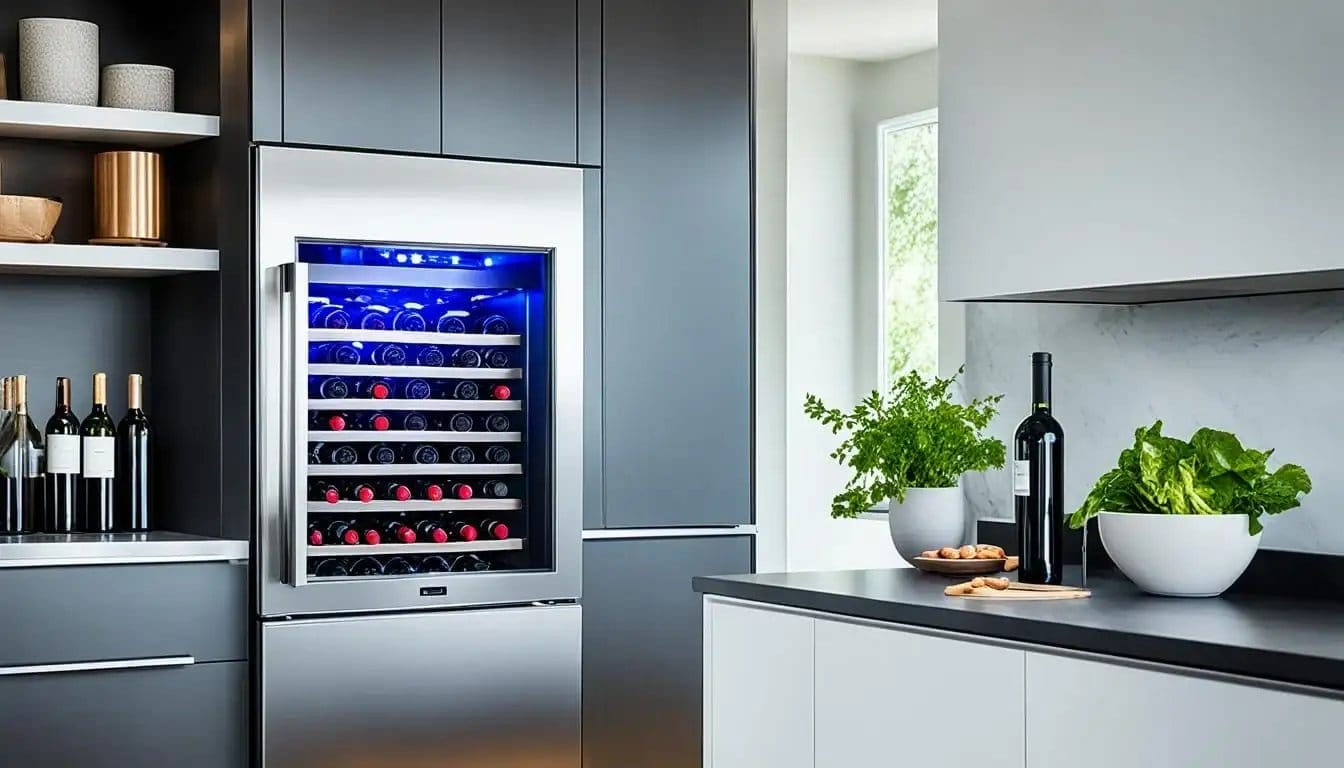What are the optimal wine fridge temperatures? The range can vary depending on the type of wine and the duration of storage. In most wine fridges, the temperature range typically falls between 40°F – 75°F (4°C – 24°C).
By following these wine storage tips, you can be confident that your wines will be preserved in their best condition, ready to be enjoyed whenever you please. Read on!
Key Takeaways:
- Storing and serving wine at the proper temperature is crucial for preserving its flavor.
- Both red and white wines should be stored at the same temperature, regardless of their serving temperature.
- Most wine fridges have a temperature range of 40°F – 75°F (4°C – 24°C).
- For short-term storage, maintain a constant temperature of 50°F to 55°F (10°C-12.8°C) for white wines and 55°F to 65°F (12.8°C-18.3°C) for red wines.
- For long-term storage, a slightly colder temperature of 52°F to 57°F (11°C-14°C) is considered ideal.
Short-Term Storage vs Long-Term Storage
When it comes to storing wine, understanding the differences between short-term and long-term storage for choosing the right temperatures and maintaining the quality and flavors of your favorite wines.
1. Short-Term Storage
- For short-term storage, which typically refers to storing wine for less than 6 months, it is recommended to keep the wine fridge at a constant temperature between 50°F to 55°F (10°C-12.8°C) for white wines, 40-45°F (4.4°C – 7.2°C) for sparkling wines and 55°F to 65°F (12.8°C-18.3°C) for red wines.
- This temperature range is ideal for preserving the wine’s freshness and ensuring that it ages gracefully during this shorter period.
- Note that for short-term storage of red and white wines, it is best to use a dual-zone wine fridge.
- Note that for short-term storage for sparkling wines you may want to store them in a regular fridge.
2. Long-Term Storage
- For long-term storage involves storing wine in an extended period, usually more than 6 months, a slightly colder temperature of 52°F to 57°F (11°C-14°C) is considered optimal.
- This cooler temperature helps maintain the wine’s integrity over time, allowing it to develop complex flavors and aromas as it matures.
Ideal Temperature For Red Wines
When it comes to storing red wines, the ideal temperature can vary depending on their body. To ensure optimal preservation and enhance their flavors, it’s important to store red wines at the right temperature. Let’s explore the recommended temperature ranges for different types of red wines:
1. Full-Bodied Red Wines
- Full-bodied red wines like Red Zinfandel, Syrah, and Bordeaux thrive at 63° – 65°F (17.2°C – 18.3°C).
- This temperature range allows the flavors to develop fully, resulting in a rich and robust taste profile.
2. Medium-Bodied Red Wines
- Medium-bodied red wines, such as Malbec, Merlot, and Rioja, should be stored at slightly lower temperatures of 60° – 62° F (15.5°C – 16.7°C).
- This range helps to balance the flavors, highlighting the nuanced characteristics of these wines.
3. Light-Bodied Red Wines
- For light-bodied red wines like Chianti, Barbera, and Pinot Noir, a temperature range of 55° – 60°F (12.8°C – 15.5°C) is best.
- Rosé wines can benefit from the lower end of this temperature range, at 55°F (12.8°C) allowing their delicate and fruity notes to shine through.
- This cooler temperature brings out the delicate flavors and ensures a refreshing drinking experience.
By storing your red wines at the ideal temperature, you can truly appreciate their unique qualities and enjoy a memorable tasting experience. Remember to monitor and maintain the temperature consistently to preserve the integrity of these wines.
| Wine Type | Ideal Temperature Range |
|---|---|
| Full-Bodied Red Wines | 63-65°F (17.2°C – 18.3°C) |
| Medium-Bodied Red Wines | 60-62°F (15.5°C – 16.7°C) |
| Light-Bodied Red Wines | 55-60°F (12.8°C – 15.5°C) |
| Rosé Wines | 55°F (12.8°C) |
Ideal Temperature For White Wines & Sparkling Wines
When storing white and sparkling wines, a lower temperature is essential to maintain their freshness and enhance their flavors. Let’s explore the ideal temperature ranges for these wines:
1. Full-bodied White Wines
- Full-bodied white wines like Viognier and Chardonnay should be stored at a temperature range of 52°-55°F (11°C – 12.8°C).
- This slightly cooler temperature allows these wines to retain their rich flavors and complex aromas.
2. Medium-bodied White Wines
- For medium-bodied white wines such as Riesling and Chablis, a temperature of 50°-52°F (10°C – 11°C) is ideal.
- This temperature range helps preserve the delicate balance of flavors in these wines.
3. Light-bodied White Wines
- Light-bodied white wines like Sauvignon Blanc and Pinot Grigio should be stored at a slightly lower temperature of 46-48°F (7.8°C – 9°C).
- This cooler temperature helps maintain their fresh and crisp characteristics.
4. Sparkling Wines
- Sparkling wines, including Prosecco and Champagne, require a cooler temperature of 40-45°F (4.4°C – 7.2°C).
- This lower temperature range keeps the bubbles intact and ensures a delightful effervescence when the wine is opened and enjoyed.
By storing white and sparkling wines at the ideal temperatures, you can fully savor their distinct flavors and enjoy a refreshing drinking experience. Keeping them chilled contributes to their overall quality and allows you to appreciate the craftsmanship and complexity of these wines.

Wine Fridge Temperature Range
Maintaining the optimal temperature in a quality wine cooler is vital to preserve the flavors and aromas of your favorite wines.
- Most wine fridges on the market offer a temperature range between 40°F and 75°F (4°C – 24°C)
- By following the recommended temperature guidelines for different types of wine as above, you can ensure that your wine remains in its prime condition.
- Constant fluctuations in temperature can negatively impact the quality of the wine, altering its taste and diminishing its overall appeal. In addition, overfilling the fridge can disrupt its ability to maintain a constant and ideal temperature.
- Proper maintenance and temperature control are essential for preserving the integrity of your wine collection.
- When you invest in a wine fridge with the appropriate temperature range and adhere to the recommended guidelines, you can enjoy your favorite wines at their best.
Proper Wine Storage Tips
Follow these tips to ensure optimal wine storage and maintain the longevity of your collection:
1. Choose The Location For Your Wine Fridge
- When setting up your wine fridge, choose a location away from harsh environments such as non-air-conditioned garages or patios in hot climates.
- These areas can expose your wine to high temperatures and fluctuations, which can damage the quality of the wine over time.
2. Follow Manufacturer’s Recommendations
- Every wine fridge has a recommended maximum capacity. Follow these guidelines to ensure proper air circulation and temperature control.
- Overfilling the fridge can hinder its ability to maintain a constant temperature, affecting the preservation of your wines.
3. Buy Based On Future Needs
- Consider your future wine collection growth when purchasing a wine fridge. Choose a fridge with a larger capacity than your current needs to accommodate any additions to your collection.
- Wine fridges operate more efficiently when slightly underfilled, as it allows for better air circulation.
4. Store Wine Bottles Horizontally
- Storing wine bottles horizontally helps keep the cork moist, preventing it from drying out and allowing air to seep into the bottle.
- This position also helps to prevent sediment from settling at the bottom of the bottle, ensuring better taste when pouring.
5. Avoid Strong Odors
- Keep your wine fridge away from strong-smelling substances such as cleaning agents, spices, and strong cheeses.
- Wine is susceptible to absorbing odors, which can negatively impact its flavor and aroma.
6. Maintain A Constant Temperature
- Consistency is key when it comes to wine storage temperature.
- Fluctuations in temperature can cause the wine to expand and contract, leading to oxidation and potential spoilage.
- Aim to maintain a constant temperature within the recommended range for your stored wines.

Single-Zone And Dual-Zone Wine Fridges
Wine fridges are available in single-zone and dual-zone models, each with its own set of advantages and considerations. Let’s check out the differences between these two types of wine fridges and the impact on wine storing temperatures.
1. Single-Zone Wine Fridges
A single-zone wine fridge is an excellent choice for beginners and those who have a large collection of wines to store.
- These fridges have a single temperature setting, typically ranging from 40°F to 65°F, allowing you to maintain a consistent temperature throughout the unit.
- They are ideal for long-term storage of one specific type of wine of the same range of temperature, providing a stable and controlled environment to preserve the flavors and aromas.
- Single-zone fridges are more economical and straightforward to use, as you don’t need to worry about adjusting multiple temperature zones.
2. Dual-Zone Wine Fridges
If you’re a wine enthusiast who enjoys a variety of wines and wants more versatility in storage options, a dual-zone wine fridge might be the perfect fit for you.
- These fridges offer the ability to independently adjust the temperatures of two separate storage areas.
- Typically, one zone is designed for long-term storage (around 52°F to 57°F), while the other zone is set at a slightly cooler temperature (around 40°F to 55°F) for short-term storage or serving purposes.
- Dual-zone fridges are ideal for those who want to store both red and white wines or have different temperature preferences for various wine types.
- They provide the convenience of storing your wines at their optimal temperatures and allow you to serve them at their best.
3. Consider Your Needs
When selecting a wine fridge, consider whether you are exclusively storing wine or if you have other beverages that need to be kept cold as well.
- If wine is your main focus, both single-zone and dual-zone fridges can meet your needs.
- If you also need space for other drinks like beer or soft drinks, a dual-zone fridge with adjustable shelves or compartments might be more suitable.
Understanding the differences between single-zone and dual-zone wine fridges, you can make an informed decision based on your specific requirements. Whether you opt for a single-zone fridge for simplicity or a dual-zone fridge for added flexibility, investing in a wine fridge to ensure that each bottle is stored at the right temperature.
Bottom Line
Overall, proper temperature control is vital for preserving the quality and flavors of your favorite wines. Understanding the optimal temperature ranges for different types of wines, choosing the right wine fridge with the appropriate temperature range, and following tips for proper wine storage will ensure a delightful wine-drinking experience.
When it comes to storing your wines, it is important to consider your specific storage needs, the potential growth of your wine collection, and the temperature requirements of the wines you enjoy. Maintaining the optimal temperature, you can fully appreciate the complex aromas, flavors, and textures that make each bottle unique.
Remember to invest in a wine fridge that offers a temperature range suitable for your collection and desired storage options.
Happy cooling!
FoodiesFridge










